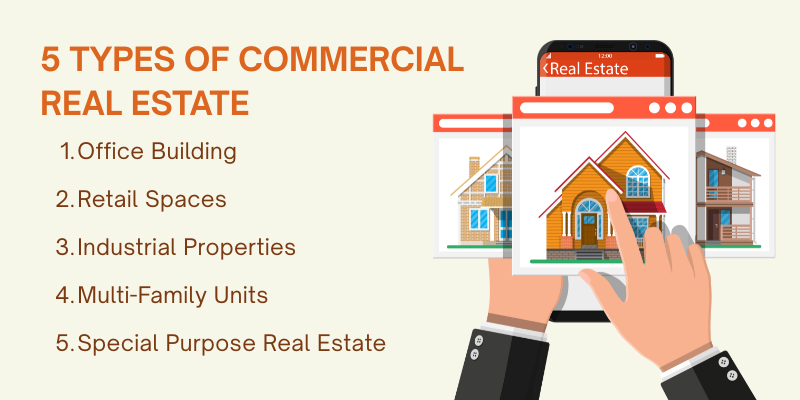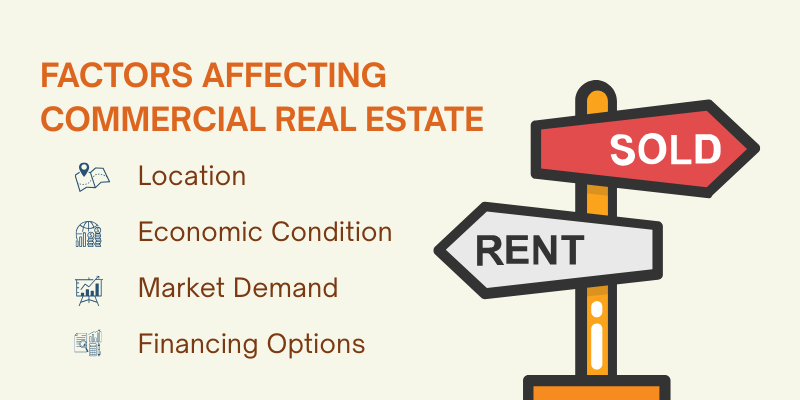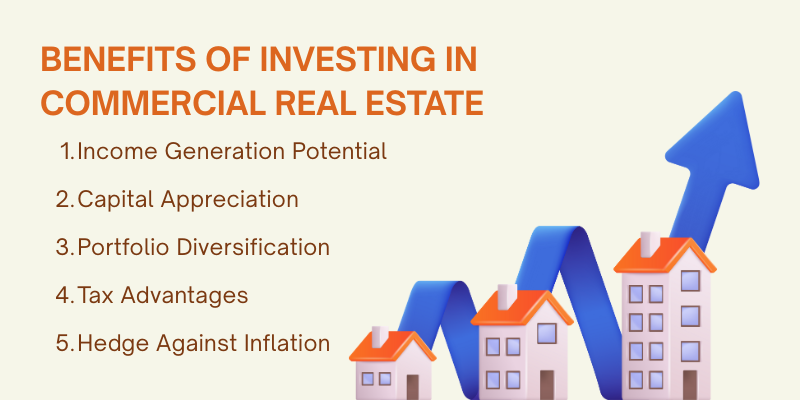Commercial real estate is a big part of your everyday life.
But what is commercial real estate? Commercial real estate (CRE) refers to properties used for business purposes rather than residential living.
This includes office buildings, retail spaces, industrial properties, and multi-family units. The scope of commercial real estate extends to any property that generates income for its owner, either through rental income or capital appreciation.
As businesses look to expand, the demand for commercial real estate continues to grow, making it an attractive investment opportunity.
For businesses seeking to enhance their market presence, partnering with a real estate marketing agency can be crucial for effective exposure.
Investing in commercial real estate requires understanding factors like location, market trends, and tenant demand. It also involves navigating legal requirements, financing options, and potential risks.
Whether you're considering commercial property for investment or as a space for your business, it's crucial to understand the complexities involved in this dynamic industry.
A digital transformation strategy can also help streamline property management and tenant communication, improving overall efficiency.
In this blog, we will explore everything you need to know about commercial real estate.
5 Main Types of Commercial Real Estate
Commercial real estate (CRE) is a broad sector that offers various opportunities depending on the specific needs of businesses and investors. These properties can be used for different purposes, ranging from office space to industrial production.

Here's an in-depth look at the main types of commercial real estate:
1. Office Buildings
Office buildings are properties specifically designed for businesses to operate, ranging from small buildings with a single tenant to large skyscrapers with multiple tenants.
They are categorized into three classes based on quality and amenities:
- Class A: High-end properties with premium locations and modern facilities. Often leased by large corporations and high-profile tenants.
- Class B: Good-quality buildings with decent amenities, usually older than Class A buildings but still suitable for businesses.
- Class C: Older and less well-maintained buildings, often in less desirable locations, typically occupied by small businesses or budget-conscious tenants.
The value of office buildings is largely influenced by their location, accessibility, parking, and proximity to public transport, as these factors determine the ease with which businesses can attract clients and employees.
For real estate marketers, digital strategies like digital marketing are critical for showcasing these spaces to potential tenants.
2. Retail Spaces
Retail spaces are properties leased to businesses selling goods and services directly to consumers. These can range from standalone stores to large shopping malls and even strip malls.
Retail spaces include:
- Shopping malls: Large commercial complexes housing numerous retail stores, often with additional facilities like restaurants, cinemas, and entertainment.
- Strip malls: Smaller than malls, strip malls are usually single-story buildings with a row of stores that share a parking lot.
- Standalone stores: Independent stores located in high-traffic areas, such as along busy streets or in commercial districts.
The success of retail spaces is highly dependent on foot traffic, visibility, and the surrounding area’s demographics.
Retail real estate is also affected by trends such as online shopping and consumer habits, making it a more volatile market.
Understanding what does contingent mean in real estate can also be a critical part of retail lease negotiations, particularly when conditions need to be met before a transaction is final.
3. Industrial Properties
Industrial properties include warehouses, distribution centers, and manufacturing facilities. These properties are critical for businesses involved in production, storage, and logistics.
Industrial properties can be used for various purposes, including:
- Warehouses: Used for storing goods and materials, often for distribution purposes. They are typically located near major highways or ports for ease of access to transportation.
- Factories: Industrial sites used for manufacturing goods. These properties are often customized to suit the specific requirements of production processes.
- Distribution centers: Facilities designed to quickly distribute goods to various retailers, often featuring large loading docks, high ceilings, and easy access for trucks.
Industrial properties are highly dependent on logistics and transportation infrastructure, so location near highways, ports, or railroads is crucial for maximizing efficiency and reducing operational costs.
For businesses looking to secure industrial properties, employing a B2B marketing approach could be essential to attract the right clients.
4. Multi-Family Units
Multi-family units are residential buildings that contain more than one housing unit, such as apartment complexes, duplexes, or triplexes.
While they are primarily residential, when used for investment purposes (rented to tenants), they are classified as commercial real estate.
Multi-family properties are often favored by investors because:
- Steady cash flow: Rental payments provide a predictable and reliable income stream.
- Economies of scale: Managing multiple units under one roof is often more efficient than managing single-family homes.
- Appreciation potential: Well-maintained multi-family properties can appreciate in value over time, particularly in growing urban areas.
Multi-family properties range from small duplexes to large apartment buildings with hundreds of units. Investors typically look for these properties in areas with high rental demand, such as urban centers or neighborhoods with good schools and amenities.
Investors interested in entering the U.S. market might also want to know how to get a real estate license in USA to ensure they're legally compliant.
5. Special-Purpose Real Estate
Special-purpose properties are those designed for specific uses and cannot easily be converted into other types of commercial real estate. These properties often require specialized management due to their unique purpose.
Examples include:
- Hotels: Properties offering accommodation services. Hotel real estate can be highly profitable in tourist areas or urban centers with high demand for short-term stays.
- Hospitals and medical facilities: Properties used for healthcare purposes, requiring specialized design and equipment to accommodate medical services.
- Schools and universities: Educational institutions that require properties designed for classrooms, dormitories, sports facilities, and other educational services.
- Recreational facilities: Properties designed for leisure and sports, such as gyms, theme parks, or golf courses.
Special-purpose properties can be highly profitable but require significant expertise in managing their specific operations.
For instance, a short sale in real estate might come into play when dealing with distressed special-purpose properties. They may also face more regulatory hurdles due to their unique nature.
4 Key Factors Affecting Commercial Real Estate
When it comes to commercial real estate (CRE), several factors influence the success and profitability of investments. Understanding these key factors is crucial for investors, business owners, and developers to make informed decisions.

Here are the primary elements that affect the commercial real estate market:
1. Location
Location is a primary factor in determining property value and demand. Properties in high-traffic areas with good accessibility and proximity to amenities tend to perform better. A prime location can lead to higher rental rates and property appreciation.
2. Market Demand
Market demand influences rental prices and property values. High demand for office, retail, or industrial space leads to better profitability. Factors such as industry growth, consumer behavior, and tenant preferences drive this demand.
3. Economic Conditions
Economic factors like interest rates, inflation, and economic growth directly impact the commercial real estate market. High interest rates can reduce demand, while a strong economy can boost business expansion and demand for commercial space.
4. Financing Options
The availability of favorable financing options, including low-interest loans and equity investments, affects real estate acquisitions. Understanding these financing options helps investors manage costs and maximize returns.
Top 5 Benefits of Investing in Commercial Real Estate
What is commercial real estate and why should you invest in it? Investing in commercial real estate (CRE) provides numerous benefits, making it an attractive choice for many investors.

Here are the primary benefits:
1. Income Generation Potential
Commercial real estate properties often provide a steady stream of income through rents or leases. With long-term tenants in place, especially in office, retail, or multi-family buildings, investors can enjoy consistent cash flow. Rental income is generally more stable compared to other investments like stocks.
2. Capital Appreciation
In addition to income generation, commercial properties tend to appreciate over time. As the demand for space increases, the value of the property rises, resulting in potential capital gains when sold. This makes CRE an attractive long-term investment for building wealth.
3. Portfolio Diversification
Commercial real estate offers excellent diversification for an investment portfolio. It has a low correlation with traditional asset classes like stocks and bonds, meaning it can help reduce risk by balancing market volatility.
4. Tax Advantages
Investing in commercial real estate offers several tax benefits. Owners can deduct expenses such as mortgage interest, property depreciation, and maintenance costs, which can significantly reduce taxable income.
In some cases, investors can also take advantage of 1031 exchanges to defer capital gains taxes by reinvesting profits into new properties. These incentives make CRE a smart choice for maximizing returns while minimizing tax liabilities.
5. Hedge Against Inflation
Commercial real estate is widely considered a strong hedge against inflation. As the cost of goods and services rises, property values and rental rates often increase as well.
This means that your rental income and asset value tend to grow with inflation, protecting your purchasing power over time. Unlike fixed-income investments, CRE allows investors to adjust lease terms to reflect changing market conditions, ensuring continued profitability.
Explore Our Digital Marketing Services!
3 Challenges in Commercial Real Estate
Investing in commercial real estate (CRE) offers substantial benefits but also presents several challenges.
Here are the key difficulties investors and property managers may face:
1. Market Volatility
The commercial real estate market is influenced by a wide range of economic factors, including interest rates, inflation, and overall economic conditions.
Market volatility can lead to fluctuations in property values, rental income, and demand. For example, an economic downturn can result in reduced tenant demand and falling property values, making it challenging to maintain profitability.
Investors must carefully monitor market conditions and adjust their strategies accordingly to mitigate risks during uncertain times.
2. Tenant Risk
Commercial properties rely on tenants for rental income, and tenant risk is a major concern for investors. High tenant turnover, non-payment of rent, or tenants who vacate early can significantly impact cash flow.
Additionally, long-term leases may expose landlords to the risk of tenants defaulting on payments or being unable to renew contracts.
To minimize tenant risk, property owners must thoroughly vet potential tenants, ensure proper lease agreements, and maintain strong relationships with tenants to ensure stability.
3. Maintenance and Operational Costs
Commercial real estate properties often require significant ongoing maintenance and operational expenses.
These include repairs, utilities, insurance, property taxes, and managing common areas. Over time, buildings may need major renovations or updates to meet modern standards or comply with regulations.
Unexpected maintenance issues, such as plumbing or electrical failures, can disrupt business operations and lead to costly repairs. Investors must budget for these expenses and factor them into the overall profitability of the property.
Conclusion
What is commercial real estate and why is it important? Understanding commercial real estate is essential for anyone looking to invest in this sector.
With various property types like office buildings, retail spaces, and industrial properties, CRE offers opportunities for income generation, capital appreciation, and diversification.
However, it also presents challenges such as market volatility, tenant risk, and high maintenance costs that investors must manage.
By conducting thorough research, making informed decisions, and staying updated on market trends, investors can capitalize on the potential of commercial real estate.
For those seeking expert guidance, partnering with a trusted real estate marketing agency like Centric can help in navigating the market efficiently.
With careful planning and risk management, CRE can provide long-term financial growth and stability, making it a worthwhile investment choice for those seeking strong returns and portfolio expansion.









